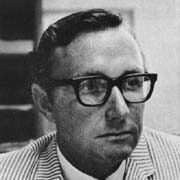John Griffin
- 1968

Fellowship Title:
- Pacific Islands
Fellowship Year:
- 1968
Fiji: The Crossroads II
Honolulu February 28, 1970 For the British, Fiji has become the white man’s burden with a vengeance, an unprofitable colonial remnant, a disturbing trust that must be honored yet brought to an uneasy independence as the once great power cut its role East of Suez. There is plenty of room for criticism of British policy in Fiji since the reluctant English took over in 1874 at the repeated invitation of the then King Cakobau backed by European businessmen. Some frequent charges: A well-meaning and convenient paternalism made most Fijians prisoners in a museum-case mentality unsuited for a modern world thrust upon them. Not only may importing Indian labor have been a mistake, it was compounded. Here as in other British colonies, some see evidence of a past divide-and-rule policy that haunts present efforts for racial harmony. Attitudes that fostered racially separate schools have not helped. Political integration could have been speeded. The economic system has continued to favor the dominant Europeans and to a lesser degree the eager Indians. Whatever the merits of
Fiji: At The Crossroads I
Honolulu February 13, 1970 One of my most vivid memories after months of travel in the Pacific Islands is of arriving in Fiji for the first time. When the plane had left the little Polynesian kingdom of Tonga, sunshine sparkled on blue sea and low coral atolls. If Tonga had problems, they seemed manageable and not of Pacific-wide importance. But Fiji obviously was something else. The scene shadowed as we flew into Suva’s Nausori Airport in late afternoon. Rain had fallen and heavy clouds still hung-over rich flatlands, a brown river, and dark mountains that stretched off to the horizon. You could sense a difference: this did not look like any simple Pacific “paradise.” In retrospect, it’s possible to assign some impending sense of tragedy, especially since it was only a short time afterwards that my leg was smashed in a near-fatal auto accident. However, jottings made then in an old notebook reflect other concerns: “Bright Fijian smiles, gay Indian saris, British order. Yet the shadows. This is no easy place …
Samoa of Samoa
Honolulu December 1, 1969 It’s easy to assume not much has happened this past year in the Samoas, the Polynesian island group divided in the days of gunboat diplomacy and big power bickering at the end of the last century. Astronauts back from the moon splashed down near Samoa. But there have been no threatened revolts or shocking scandals. Nobody is going Communist; and, in fact, some visitors wonder just where these lush isles are going or can go in the modern world. Yet in this uncertainty as the 1960s ended there were signs of potentially significant movement in both the small (Washington, D.C. size) American colony and larger, independent (since 1962) Western Samoa, a onetime German then New Zealand territory. Sadly, little or none of this movement seemed toward unification. Divided far longer than postwar Germany or Korea, Samoa’s islands continue drifting apart in politics, economics, and, most important, in culture. Because of what the world has made them, they have to be considered separately. The American Side Physically, the unincorporated
Tahiti: Romance & Reality
Honolulu, Hawaii October 5, 1969 Tahiti is far more than just the capital of French Polynesia — six small island groups scattered over a Europe-sized portion of the Southeast Pacific. Despite time and tarnish, it remains the capital of the Pacific dream — one of life’s magic words that triggers images of South Sea beauty and love. The reality of Tahiti has never been in full accord with the romance, of course. Nor is it today: Choking traffic jams mark the rush hours in the crowded capital of Papeete…High prices hit both visitors and local folk…The French and Tahitians are always greeting each other with kisses on the cheeks but most aren’t very friendly to ordinary visitors…Even the famous women may have changed; explained one local expert: “Too many French servicemen and tourists. The girls have better teeth than ten years ago, but they’re also tougher, or maybe more sophisticated Round -the- island travelers are still dazzled by the beauty of towering green peaks, lush valleys, and sunny lagoons. But they can also
A Pacific Puerto Rico?
Honolulu, Hawaii October 1, 1969 A quick Pacific quiz: Where did President Nixon goof politically in his trip around the world this summer? Where is the next Waikiki in the Pacific Islands likely to develop? Some students of world affairs and tourism may be surprised to find the answer to both questions is Guam, generally considered as a military outpost and one of Oceania’s less exotic ports of call. Such old impressions are less untrue than incomplete. Certainly this territory of the U.S. has been neither richly endowed by nature nor treated kindly by history. But it does have two assets of political and economic as well as strategic importance — location and size. Some 3, 000 miles out from Hawaii, Guam is the farthest west piece of real estate owned by the U.S. It is in the center of the prime area of American Pacific Island interest, surrounded by the separate Trust Territory. Its total area of 206 square miles makes it smaller than Singapore or Hawaii’s Molokai, but it is the
